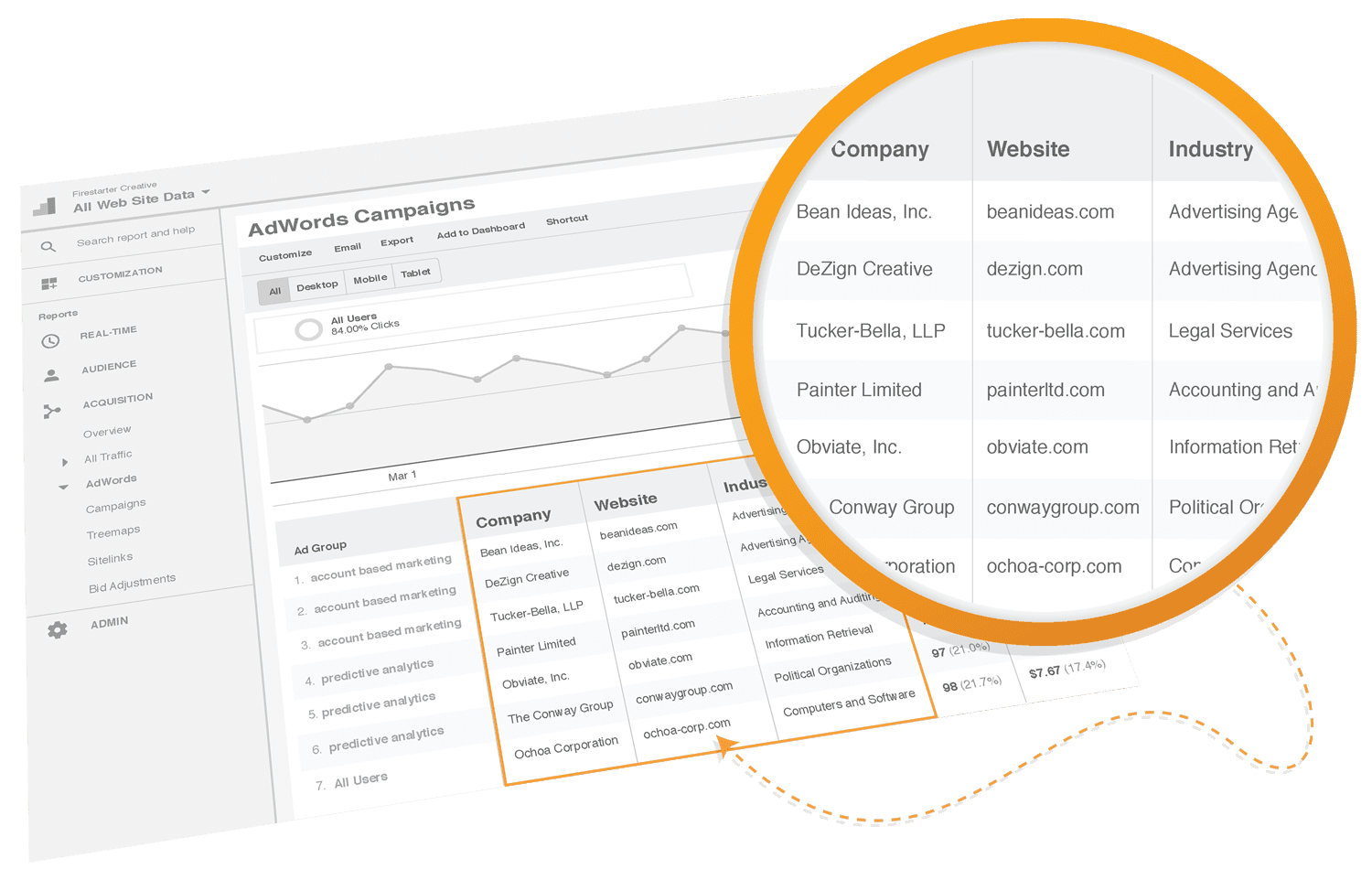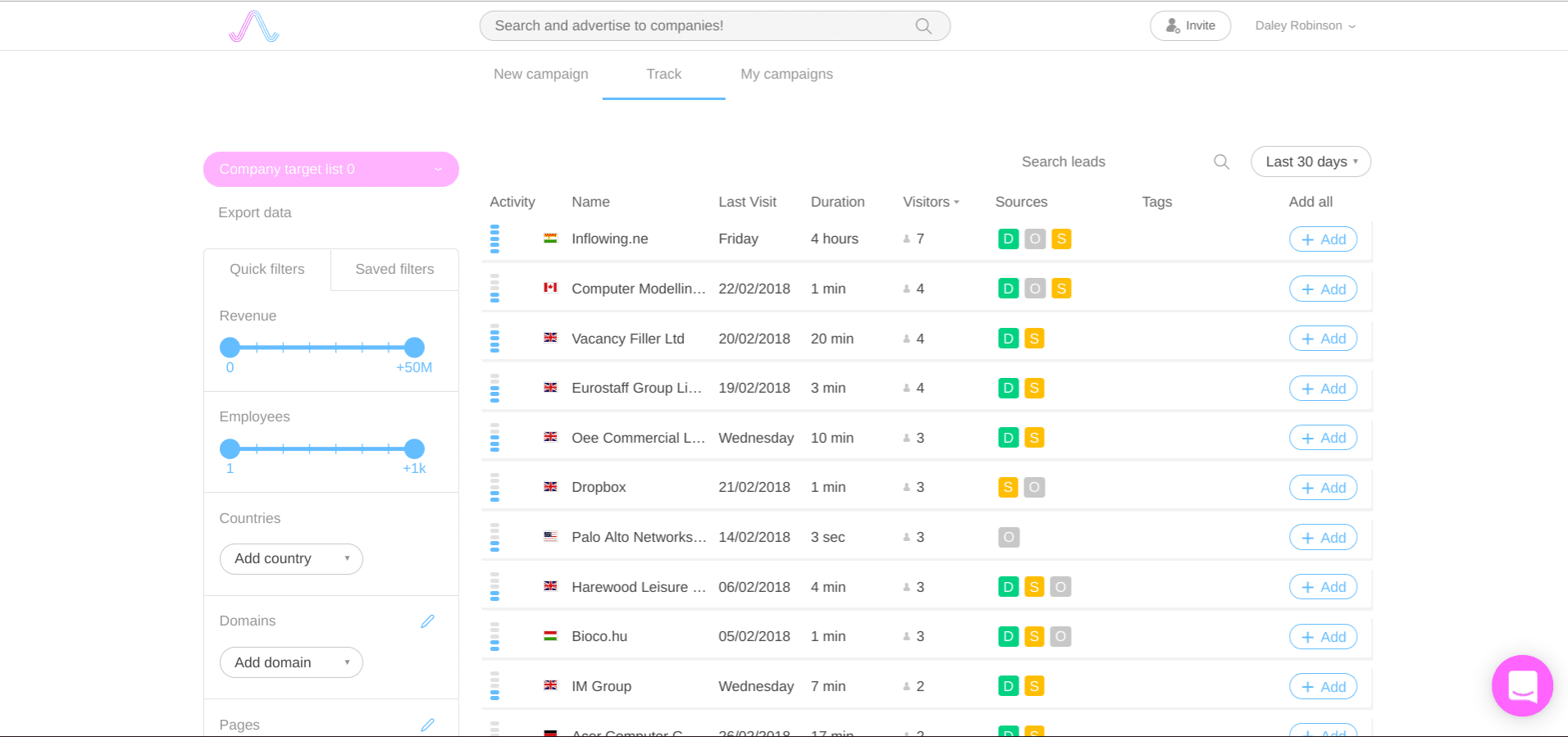Choosing the right tools and metrics for ABM success
GIVE ME DATA!
Much like every other area of marketing nowadays, there’s a decent amount of number crunching involved in an account-based marketing (ABM) campaign. Throughout the whole process, you’re going to be learning about your accounts through analysis and measurement.
Figuring out how to analyze in an ABM context and which metrics to manage are two common hurdles that ABMers face when they’re executing a project.
With that in mind, I’m going to go into some of the tools you can use to get you the data you need to make the right decisions - the ABM rockstar metrics you absolutely must measure and what you should do with them. Here goes...
Download Business Resource – Account Based Marketing Guide
Not sure if ABM is for you or want to know how to do it better, our ABM guide is your companion.
Access the Account-based marketing briefing
Analytics
We already covered the process of defining your target account list in a previous blog post. As you can see from our model below, the next step in the process is to figure out which of your target accounts are already engaged with your business.
You do this because you need to know the score. If an account has been coming to your website but hasn’t converted, it’s a content/conversion challenge.
If an account hasn’t visited your website yet and engaged in what you’re doing then it’s an outreach/engagement issue.
Obviously, your tactical approach to individual accounts will need to be reflective of this, which is why you need to do the grunt work to get to grips with what’s going on so you can make ABM decisions for success.
Web tracking software is the most efficient and dependable way of doing that. Such software seems to have been around since day dot. Nowadays, there are way too many players in the market to mention all of them, but here’s a smattering of some of the different options.
1. Demandbase
One of the original pioneers of ABM using technology and one of the darlings of Silicon Valley MarTech. Their all-in-one ABM suite integrates with a wide range of business intelligence and analytics tools, including Google Analytics.
You take a license with them and then, by the magic of the internet, you’ll start to get account-based information about your site visitors directly into your respective BI dashboard. Company data is of good quality and loads of other fields come along for the ride too, including Industry, Company Size, and Annual Revenue.
2. Kickfire
Another Silicon Valley business, Kickfire, has built its reputation on high-quality data. Having tried a number of solutions out there in the space, their firmographic data set is certainly up there with the best. When it comes to accessing it, there are options.
Kickfire LIVE Leads is a cloud-based system that you get access to - providing real-time notifications on web visitors and historic logging data. It also supports API integrations for hooking into your CRM, custom reports and loads more. Like Demandbase, they also offer a GA module if you want to bring their rich firmographic data into GA.

3. Lead Forensics
I can’t cover this section off without an honorary mention for Lead Forensics. They’ve been around for a long time, and have many customers - so clearly people value the tool. It’s probably worth checking out as part of an evaluation on functionality and cost of ownership.
4. Albacross
We covered this disruptive Nordic startup in a previous article on how to get ABM accounts to your website. For those of you who missed that article, and aren’t interested in reading it, Albacross offers web tracking functionality for free. It’s a really simple user experience, and the data quality is good.
Interestingly, it also allows you to retarget people who have visited your site with account-based advertising. So that’s something up its sleeve over the competition and clearly the commercial underpinning to the free giveaway of the web tracking.

Many marketing automation systems (MAS) now include IP tracking as standard. If yours doesn’t, it might be worth investigating moving systems if you can tolerate the undoubted stress that comes with a systems change.
Even though Albacross is free, getting web tracking going at the MAS level will help drive your inbound strategy too, which as a B2B organization is almost certainly going to be something you’re either doing or interested in doing in the near future.
Measurement
One area that many ABM marketers get stuck on is the paradox of numbers. That is, trying to apply standard marketing measurement to ABM. Frankly, it doesn’t stick. If you’re into measuring reach or number of total impressions, ABM is always going to stack up badly.
Hopefully everyone around the table gets this early on in the process - otherwise, you wouldn’t have had enough internal buy-in to get your project to this point.
But don’t let yourself slip into old habits. Particularly when the chips are down, and the customers aren’t rolling in, many marketers have a tendency to hide behind other, more vanity-based metrics. Do this at your peril! If you dump it down, people will see it as just another hair-brain marketing idea and go back to what they were doing previously.
The reason I love ABM like it’s one of my children is that it brings sales and marketing completely in alignment. It does this because, when done well, sales and marketing are sharing the same metrics for measurement.
If I’m pitching ABM, I tend to be very direct on this matter. For me, the only thing that matters is by the end of your campaign, how many accounts have you converted to a ‘W’: who is a win.
If your ABM campaign is purely prospects, how many new accounts from your list have you onboarded? If it’s about customer retention, then how many customers have you retained? You get the picture.
It’s only when both sales and marketing focus on account retention or acquisition that ABM will deliver what it promised to at the outset.
Other measurements that will come in handy, either for individuals to own as KPIs, or as part of the regular reporting into monthly management or board meetings include:
1. Engagement
We started this blog by talking about analysis. Engagement is how this fits into a broader measurement discussion in the context of ABM. For the members of your ABM project team to be able to add individual value, particularly the marketing members, you need to be measuring engagement across your campaign activities and channels.
This is the only way to identify people who need moving through the funnel, whether they’ve completely stopped or are just…moving...really…slowly. This is a supporting metric and should never be the actual focus. If it is...stop!
2. In-funnel Conversion Rates
Keeping track of in-funnel conversion rates helps you to manage exceptions and give attention to certain areas when required.
Very much a precursor to the main ABM metric - target accounts retained/acquired - the actual metrics that are relevant will depend entirely on your blend of campaign tactics. That said, I’ve haven’t seen an ABM campaign yet that doesn’t include the number of appointments and the number of CRM opportunities.
3. ROMI (Return on Marketing Investment)
Someone at some point is going to ask you what your ROI is. And if you execute your campaign neatly, you’re going to be able to proudly tell them. It’s worth pointing out though this is not much of a useful metric to report in regularly.
That's because ABM is a demand generation strategy, rather than a tactical campaign, and as such you don’t always see the fruits of your labour until much later in the process.
You need to think how long the typical buyer’s journey is in your sector. How long does it usually take to close deals? The answer to that question should form the basis for internal expectation setting as to when you start looking financially at what you’ve spent on ABM and what you’ve got back in revenue or gross profit.
Reporting
If those are the metrics then what about communicating them? How frequently should you report and to whom?
The main reporting should take place within your ABM project team. Updates on some of the metrics, with commentary, in addition to overall progress reports against the project plan will be a typical item on the agenda for the ABM project team meeting.
The frequency of reporting, in that case, is more of a matter of how often the project team should meet to keep things on track. Don’t be tempted to go for once a month. It’s too long. Once a week may be a little tight. In our client projects, we tend to recommend every two weeks to balance keeping it on everyone’s radar with respect for people’s time.
In terms of wider reporting, you need to ensure that you’re reporting back into the business on the project. You need to take people along on that journey. This is mainly because ABM is certainly more of a marathon than a sprint, and you may go a number of months, and in some cases years, without making progress.
Without a stream of information going into the senior management team, you could be in a position where it turns into a political hot potato and the project loses its support - or even worst funding.
At the most extreme level, it could be your neck on the line. So keep talking and taking people on that journey and figure out which of the metrics we explored before are useful to the wider business - and consistently deliver them.
The frequency of reporting to the wider business will likely be driven by other people, rather than you, but monthly is very common owing to monthly board reports or management information.
There might seem a lot to get your head around when it comes to analysis, measurement, and reporting but it’s all must-have stuff as part of the ABM mix.
And let’s face it, you want to give yourself the best possible chance of getting through the very end of an ABM project having learned lots, smashed your initial targets and been recognized internally as someone who can drive success.
So get it done!









